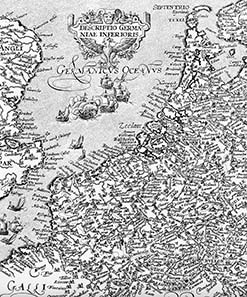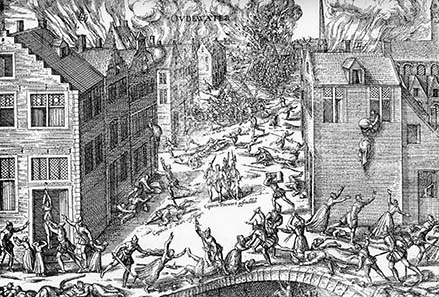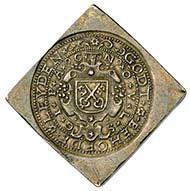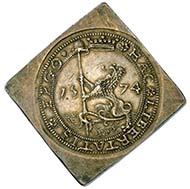On October 7th, 1571, the Spaniards gained a glorious victory over the Ottoman fleet in the Battle of Lepanto. At first sight, the location where the battle took place seems to be too far away to have any influence on the Dutch War which was rumbling in the Spanish provinces since 1568. However, it was exactly so: Thanks to the victory over the Turks, the Spaniards were in the position to pull out soldiers from the Mediterranean area and to field them against the rebellious Dutch. The governor of the Netherlands, Duke of Alba – notorious since the dramas written by Friedrich Schiller –, could count on reinforcements and did not need to adjust his further operations to diplomatic issues anymore. He took drastic measures and hence exacerbated a number of cities which hitherto had been considerate towards Spain.
Map of the territories of Holland and Zeeland which William of Orange quickly won round.
William of Orange, therefore, came upon a climate favorable to his plans when he marched into the Netherlands a second time in 1572. Most of the cities of Holland and Zealand, including proud Leyden, sided with him.
William of Orange.
Leyden, Roman Lugdunum Batavorum, ranged amongst the most important cities in Holland. Until 1420, a burgrave resided there. Since that time, Leyden developed into a self-assured commercial town whose citizens were open-minded about Protestantism and Calvinism. They keenly supported William of Orange who had to pull back from the Netherlands as early as August 1572. Hence, the cities which so quickly had positioned themselves against Spain were left without protection. For that they atoned. The Spanish troops re-conquered one city after another for their king. Especially hard up were Mechelen and Zutphen – these two surrendered by choice but were plundered and pillaged all the same, as if they had been taken by the Spaniards after a long siege.
If Leyden had been conquered it would have faced a similar fate as Oudenarde which was conquered in 1582 after a long siege.
That example was a warning to other cities allied with William that it would be useless to surrender. By contrast, they decided to give the enemy a hard fight. Haarlem shone a light for all patriots. Although the city had to surrender eventually, the siege had cost the lives of so many Spaniards that Haarlem was henceforth referred to as “graveyard of the Spaniards”.
All these examples Leyden bore in mind when it was blocked by the Spaniards on August 21st, 1573. No supplies came into the city, and nobody could leave it. Very soon, the citizens were tormented with hunger. To still retain control over the communal life the city council of Leyden issued a number of edicts including several regulations about how to ensure an well-arranged economic life.
On November 12th, 1573, the St. Catherine’s hospital was authorized to mint copper coins worth 1/4 stuiver. On December 19th and 24th, 1573, the council decided that more coins were needed. Since there was not enough precious metal at hand, paper money worth 1 and 1/4 gulden ought to be issued. To make counterfeiting difficult, the notes were “minted” with coin dies. But even in a besieged city bank notes obviously were not very popular. As early as March 27th, 1574, therefore, the bank notes were withdrawn and exchanged for copper coins.
Shortly thereafter, Leyden was able to breathe easily. Louis of Nassau, brother of William of Orange, had recruited an army – by means of French subsidies – to relieve the pressed city. The Spaniards indeed abandoned their besiegement; they confronted the newly recruited army and wiped out the inexperienced mercenary soldiers, to a man, on April 14th, 1574. Louis, too, was killed in the battle. That interlude had bought Leyden only very little time which the city fathers did not even make good use of to provide the city with new supplies.
LEYDEN. Emission from July 10th, 1574. Double taler. City coat of arms, cartridge, legend NOVLS – GIPAC (Nummus obsidionalis urbis Lugdunensis sub gubernatione illustrissimi principis Auraici = Emergency coin of the city of Leyden under the rule of the excellent Prince of Orange) / GODT BEHOEDE LEYDEN. Rv. lion striding l., in both paws pole with liberty cap on the top and the date 15-74; legend HAEC LIBERTATIS ERGO (= all for the sake of liberty). From Hess-Divo 300 (2004), 1211.
Hence, everything was back to normal when the Spaniards blocked Leyden again. The citizens had no fresh food at their disposal. Hunger raged, the plague spread and the city fathers had to resort to the silver church ornaments to issue a new emission of coins to which the coin belongs that is shown here. The value of the emergency coins was 28 stuiver for one taler and 14 for half a taler, respectively. Our example was minted on a planchet with the weight of a double taler with the dies of a taler.
At the end of September the situation had become so desperate that the city fathers decided to draw to the last resort. They cut through the dikes and flooded the surroundings of the city. It made the estates unfruitful for years to come, but the Spaniards could not maintain their siege anymore. They were forced to pull back, and on October 3rd, 1574, Leyden welcomed the Geuzen as liberators. One third of the 18,000 inhabitants had died during the siege. On the city’s brave resistance, William of Orange invested Leyden with the rank of a university city. In 1575, Leyden therewith got the first university of the Netherlands. Until the present day, the citizens of Leyden celebrate their liberation with a huge fair each year on October 3rd.
Sincere thanks are given to the Zurich Central Library for the copperplate prints and the permission to reproduce them. Special thanks are owed to lic. phil. Michael Kotrba, head librarian of the special collections of the Zurich Central library.








